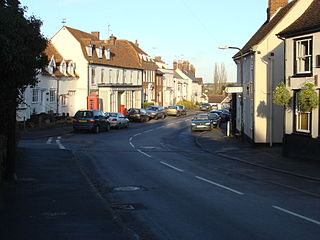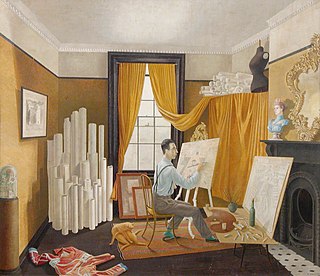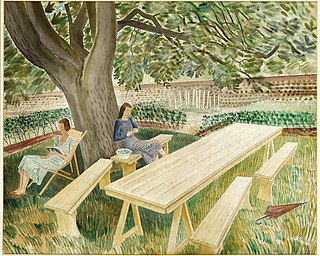
Roger Eliot Fry was an English painter and critic, and a member of the Bloomsbury Group. Establishing his reputation as a scholar of the Old Masters, he became an advocate of more recent developments in French painting, to which he gave the name Post-Impressionism. He was the first figure to raise public awareness of modern art in Britain, and emphasised the formal properties of paintings over the "associated ideas" conjured in the viewer by their representational content. He was described by the art historian Kenneth Clark as "incomparably the greatest influence on taste since Ruskin ... In so far as taste can be changed by one man, it was changed by Roger Fry". The taste Fry influenced was primarily that of the Anglophone world, and his success lay largely in alerting an educated public to a compelling version of recent artistic developments of the Parisian avant-garde.

Benjamin Lauder Nicholson, OM was an English painter of abstract compositions, landscapes, and still-life. He was one of the leading promoters of abstract art in his country.

Great Bardfield is a large village in the Braintree district of Essex, England. It is located approximately 9 mi (14 km) northwest of the town of Braintree, and approximately 12 mi (19 km) southeast of Saffron Walden.

Edward Bawden, was an English painter, illustrator and graphic artist, known for his prints, book covers, posters, and garden metalwork furniture. Bawden taught at the Royal College of Art, where he had been a student, worked as a commercial artist and served as a war artist in World War II. He was a fine watercolour painter but worked in many different media. He illustrated several books and painted murals in both the 1930s and 1960s. He was admired by Edward Gorey, David Gentleman and other graphic artists, and his work and career is often associated with that of his contemporary Eric Ravilious.

Wilhelmina Barns-Graham CBE was one of the foremost British abstract artists, a member of the influential Penwith Society of Arts.

John Arthur Malcolm Aldridge was a British oil painter, draftsman, wallpaper designer, and art teacher in the United Kingdom. He was elected an Associate of the Royal Academy (ARA) in 1954 and a Royal Academician (RA) in 1963.
Stanley Clifford-Smith (1906–1968) was an English Expressionist painter and textile designer who was active as an artist in the 1940s, 1950s and 1960s.
Audrey Cruddas (1912–1979) was an English costume and scene designer, painter and potter.

The Fry Art Gallery is an art gallery in Saffron Walden, Essex. Recognised as an Accredited Museum by Arts Council England, it displays work by artists of national significance who lived or worked in North West Essex during the twentieth century and after. The gallery is known for its comprehensive collection of work by the Great Bardfield Artists, including Edward Bawden and Eric Ravilious.
Betty Mona Desmond Ayers, known as Duffy Ayers, was an English portrait painter. She was known for most of her life by the nickname "Duffy".
William Michael Rothenstein was a British printmaker, painter and art teacher.
Elizabeth Joan Glass (1915–2000), was an English textile designer and painter.

Marianne Straub OBE was one of the leading commercial designers of textiles in Britain in the period from the 1940s to 1960s. She said her overriding aim was: "to design things which people could afford. ... To remain a handweaver did not seem satisfactory in this age of mass-production".
Denis Adeane Mitchell was an English abstract sculptor who worked mainly in bronze and wood. A prominent member of the St Ives group of artists, he worked as an assistant to Barbara Hepworth for many years.
Paul Feiler was a German-born artist who was a prominent member of the St Ives School of art: he has pictures hanging in major art galleries across the world.

Botallack is a village in west Cornwall, England, United Kingdom. It lies along the B3306 road which connects St Ives in the east to the A30 road, near Land's End. The village is included in the St Just in Penwith division on Cornwall Council. The original 1970s BBC television series Poldark was filmed partly in Botallack, using Manor Farm as Nampara. The Manor House, part of the Tregothnan estate, is a Grade II* listed building, dating from the 17th century.
Bernard Cheese was an English painter and printmaker, a fellow of the Royal Society of Painter-Printmakers. His works are found in internationally important collections in the UK and US.

Eileen Lucy "Tirzah" Garwood was a British wood-engraver, painter, paper marbler, author, and a member of the Great Bardfield Artists.
Chloë Cheese is an English illustrator, painter and print-maker.
Walter Hoyle (1922–2000) was an English artist, known for his prints, watercolours and illustration. He was a central figure in the Great Bardfield group of artists and a close associate of Edward Bawden. He taught at the Central School, London, and, for twenty years, at the Cambridge School of Art.












